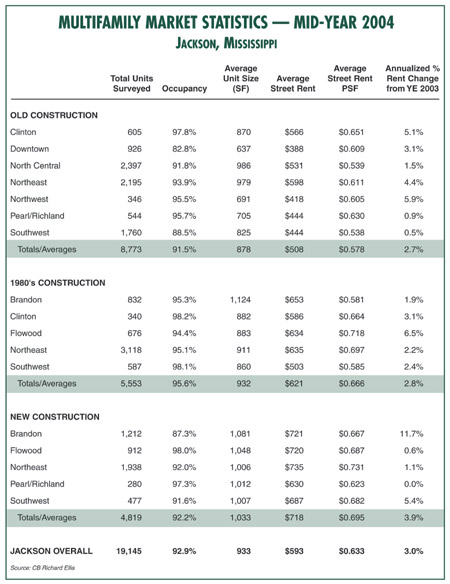|
SOUTHEAST SNAPSHOT, OCTOBER 2004
Jackson Multifamily Market
 |
|
Blake Pera
Vice President
CB Richard Ellis
|
|
Jackson, Mississippi, like many other Southeast markets,
is seeing a rising trend in multifamily development in the
form of mid-sized tax credit properties. “A lack of available
land in upscale suburbs has tempered high-end construction,”
says Blake Pera, vice president of CB Richard Ellis’
Memphis, Tennessee, office.
Two significant tax credit properties have recently completed
construction and begun leasing in Jackson. Highland Park,
a 152-unit complex, is located in north central Jackson just
off Interstate 55. The 84-unit Park Springs is located in
the Clinton submarket of Jackson. Park Development of Jackson
developed both properties.
Recent market rate properties that have completed construction
include The Gables, with 168 Class A units in Ridgeland, and
Bridgewater, with 224 Class A units in Brandon. Heritage Properties
of Madison, Mississippi, developed these communities.
Two tax credit properties totaling 328 units, one in southwest
Jackson and one in the Pearl/Richland area, are under construction
should be completed later this year. Additionally, a market
rate property in northeast Jackson totaling 248 units also
will be completed by year’s end.
With the new Nissan manufacturing facility just north of Jackson,
it seems probable that the majority of development would be
in north central or northeast Jackson. “Although there
is development in these areas,” says Pera, “developers
seem to be banking on the solid growth of the entire market
for the future strength of the area, as they branch out into
nearly every submarket of Jackson.”
The overall average rental rate in Jackson is $593 per unit,
a 3 percent annualized increase over the year-end 2003 rents.
Rates range from an average low of $508 per unit for older
properties, to $621 per unit for properties constructed in
the 1980s, to an average high of $718 per unit for new construction
properties. The vacancy rate is holding steady at slightly
more than 7 percent.
Downtown areas in many second- and third-tier cities have
a common bond in the redevelopment of their inner city and
the development of new housing units in areas that, in the
past, have been predominately industrial. “Many cities,
such as Memphis, Nashville and Little Rock, cannot develop
fast enough to keep up with the in-migration trend, which
is resulting in some of the highest rents in these markets,”
says Pera.
Downtown Jackson’s residential revitalization is slowly
beginning to take shape. “Recent efforts to clean up
the area, including the condemnation of a number of dilapidated
buildings, a new downtown police substation and a designated
economic redevelopment area, may breathe life into an area
rich in heritage,” says Pera. “Downtown Jackson
has the potential to become a hotbed for commercial and residential
development.”

©2004 France Publications, Inc. Duplication
or reproduction of this article not permitted without authorization
from France Publications, Inc. For information on reprints
of this article contact Barbara
Sherer at (630) 554-6054.
|
